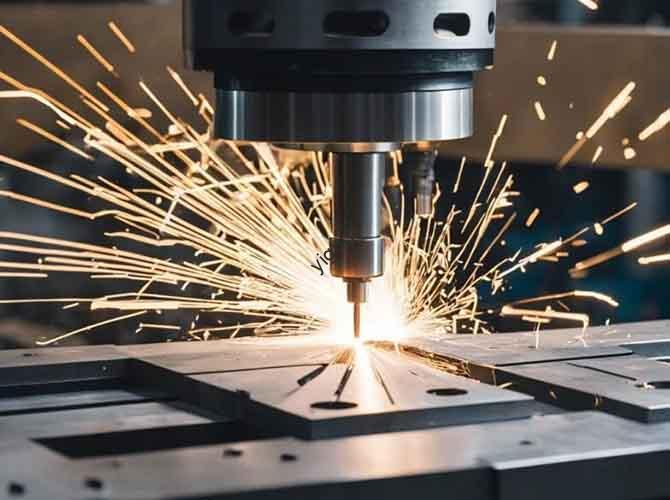En la fabricación moderna, finding a machine that balances efficiency, precisión, and ease of use is key. Enter the vertical CNC machining center (VMC)—a workhorse for processing flat parts, moldes, and small complex components. But how does it work? What makes it stand out from other machining tools? This guide answers these questions and helps you decide if a VMC is the right fit for your production needs.
1. What Is a Vertical CNC Machining Center? Definiciones principales & Características
A vertical CNC machining center is a computer-controlled machine tool where the spindle axis stands perpendicular to the worktable. This design lets tools cut workpieces from above, making it ideal for flat surfaces, agujeros, and plate-shaped parts.
Key Features at a Glance
| Característica | Descripción |
| Spindle Orientation | Vertical (perpendicular to worktable) – enables top-down cutting. |
| Structure | Simple design with fewer moving parts compared to horizontal machining centers. |
| Footprint | Compact – takes up 30-50% less floor space than similar horizontal models. |
| Costo | More affordable – entry-level VMCs start at ~\(30,000 (VS. \)80,000+ for horizontal). |
| Usability | Easy workpiece clamping, clear processing visibility, and simple program debugging. |
2. Inside a VMC: Componentes clave & Cómo trabajan juntos
A VMC’s performance depends on its core components working in harmony. Here’s a breakdown of the critical parts and their roles:
Critical Components List
- Cama: The base that supports all other parts – made of rigid cast iron to reduce vibration.
- Column: Connects the bed to the headstock, ensuring stable spindle positioning.
- Headstock: Holds the spindle and drives its rotation (speeds range from 5,000 a 15,000 RPM for most VMCs).
- Worktable: A flat surface that moves along X, Y, and Z axes to position the workpiece (typical size: 500mm x 300mm for small VMCs).
- CNC System: The “brain” – interprets G-code to control tool changes, velocidad del huso, and axis movement.
- Servo Motors: Power the worktable and spindle, asegurando precisos, smooth motion (Precisión de hasta ±0,001 mm.).
How It All Comes Together: El proceso de mecanizado
Piense en un VMC como un chef que sigue una receta: cada paso se controla a la perfección.:
- Entrada del programa: Convertir parámetros de mecanizado (profundidad de corte, velocidad, tipo de herramienta) en código G, que lee el sistema CNC.
- Configuración de la pieza de trabajo: Sujete la pieza de trabajo a la mesa de trabajo usando accesorios. (P.EJ., mordazas o abrazaderas hidráulicas) para mantenerlo estable.
- Selección automática de herramientas: El cambiador de herramientas del VMC (tenencia 10-30 herramientas) elige la herramienta adecuada según el programa.
- Corte: El husillo hace girar la herramienta., Y la mesa de trabajo se mueve a lo largo de los ejes X/Y/Z para cortar la pieza de trabajo..
- Cheque de calidad: Después de mecanizado, the VMC can use probes to verify dimensions (ensuring compliance with tolerances like ±0.005mm).
Ejemplo: A manufacturer making aluminum smartphone cases uses a VMC to drill 100+ pequeños agujeros (each 0.5mm in diameter) in one cycle—all with consistent accuracy.
3. Why Choose a Vertical CNC Machining Center? Ventajas técnicas
VMCs stand out for three key benefits that solve common manufacturing pain points:
1. High-Speed Performance
- Advanced spindle technology (P.EJ., belt-driven or direct-drive) delivers cutting speeds up to 15,000 Rpm.
- Resultado: A VMC can machine a 100mm x 100mm aluminum plate in 5 minutes—2x faster than a manual milling machine.
- Por que importa: Faster processing reduces lead times, helping you meet tight production deadlines.
2. Heavy-Duty Cutting Capabilities
- Rigid bed and column designs handle tough materials like hardened steel (arriba a 50 CDH) y titanio.
- Guión: An aerospace supplier uses a VMC to cut 10mm-thick steel brackets—no flexing, no errors.
- Causal chain: Rigid structure → less vibration → cleaner cuts → fewer defective parts.
3. Ingeniería de precisión
- High-resolution feedback systems (P.EJ., linear scales) monitor axis movement, ensuring repeatability of ±0.001mm.
- Short-nose spindle designs reduce tool runout (wobble), critical for fine details like mold cavities.
- Analogía: A VMC is like a surgeon’s scalpel—its precision lets it create parts that fit together perfectly, cada vez.
4. Yigu Technology’s Perspective on Vertical CNC Machining Centers
En la tecnología yigu, we see VMCs as the backbone of small-to-medium manufacturing. They strike the perfect balance between cost and performance—ideal for businesses making plates, moldes, or small shells. We recommend starting with a VMC if you need fast setup, Operación fácil, and consistent accuracy. Our VMC models come with user-friendly CNC systems and durable cast iron beds, reducir los costos de mantenimiento por 20% VS. competitors. For clients new to CNC, we also offer training to maximize productivity from day one.
Preguntas frecuentes
- q: Can a vertical CNC machining center process 3D curved parts?
A: Sí, Pero con límites. VMCs excel at flat or shallow curved parts (P.EJ., simple mold surfaces). For deep 3D curves, a 5-axis machining center is better.
- q: How much floor space does a typical VMC require?
A: Small VMCs (for hobby or small-batch production) need ~2m x 3m. Industrial VMCs (para trabajo de alto volumen) need ~3m x 4m.
- q: What maintenance does a VMC need to stay accurate?
A: Clean the worktable and spindle daily, lubricate lead screws every week, and calibrate the CNC system every 3 meses. This ensures consistent performance for 5+ años.
